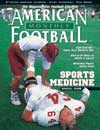AMERICAN FOOTBALL MONTHLY THE #1 RESOURCE FOR FOOTBALL COACHES
Article CategoriesAFM Magazine
|
Red Raider Run Stuntsby: Ron Harris© More from this issue Defensive football today is characterized by a wide variety of philosophies and styles. Some teams are committed to a front that penetrates, while others hit and read along the line of scrimmage. A team may have multiple fronts and personnel packages designed to both maximize its personnel as well as to offer differing looks to an offense. But no matter what your preferences and beliefs are, almost all defenses utilize line movements to help both attack the run and pressure the passer. The following is an overview of what we do here at Texas Tech based upon the system of defensive coordinator Greg McMackin. Overall Philosophy We are committed to having our players know what our philosophy is on three levels: A) Team; B) Defense; and C) Defensive Line Team There are ....The full article can only be seen by subscribers. Subscribe today!
|
|
|||||||
| HOME |
MAGAZINE |
SUBSCRIBE | ONLINE COLUMNISTS | COACHING VIDEOS |
Copyright 2026, AmericanFootballMonthly.com
All Rights Reserved





